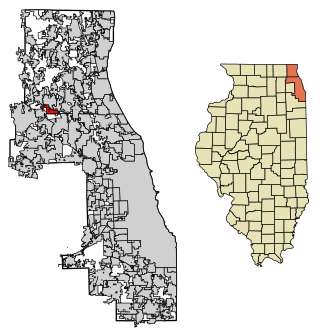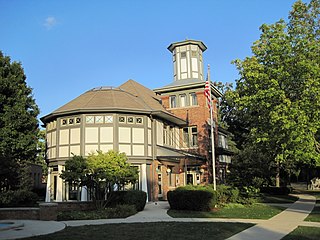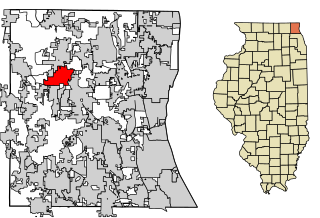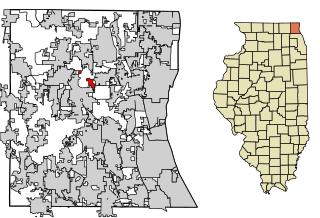
Zion is a city in Lake County, Illinois, United States. Per the 2020 census, the population was 24,655.

Lake County is situated in the northeastern corner of the U.S. state of Illinois, along the shores of Lake Michigan. As of the 2020 census, it has a population of 714,342, making it the third-most populous county in Illinois. Its county seat is Waukegan, the tenth-largest city in Illinois. The county is primarily suburban, with some urban areas and some rural areas. Due to its location, immediately north of Cook County, Lake County is one of the collar counties of the Chicago metropolitan area. Its northern boundary is the Wisconsin state line.

Deer Park is a village in Lake and Cook Counties, Illinois. Per the 2020 census, the population was 3,681. The village is one of the few left in the Chicago area that enjoy a green belt which is bordered by two large natural areas providing outdoor recreation and open space. The village is home to popular shopping and dining destinations: Deer Park Town Center and the Town Center Promenade. The town is also home to the Vehe Farm, an Illinois Centennial Farm.

Golf is a village in Cook County, Illinois, United States, incorporated in 1928. As of the 2020 census, the village had a population of 514. The community is primarily residential, and has a dedicated police department, post office, and Metra train stop.

Hanover Park is a village in Cook and DuPage counties in the U.S. state of Illinois, a suburb of Chicago. The population was 37,470 at the 2020 census. Ontarioville is a neighborhood within the village.

Huntley is a village in McHenry and Kane counties, Illinois, United States. As of the 2021 census it had a population of 28,008. It is a part of the Chicago metropolitan area.

Beach Park is a village in Benton and Waukegan townships of Lake County, Illinois, United States. Per the 2020 census, the population was 14,249.

Fox Lake is a village in Grant and Antioch townships in Lake County, Illinois and Burton Township, McHenry County, Illinois, United States. The population was 10,978 at the 2020 census. It is located approximately 57 miles north of Chicago.
Gages Lake is a census-designated place (CDP) in Warren Township, Lake County, Illinois, United States. The population was 10,637 at the 2020 census.

Gurnee is a village and suburb in Lake County, Illinois, United States. Its population was 30,706 as of the 2020 census. It borders the city of Waukegan, and is a popular tourist attraction within the Chicago metropolitan area.

Hainesville is a village in Avon Township, Lake County, Illinois, United States. Per the 2020 census, the population was 3,546. Hainesville has the distinction of being the oldest incorporated community within Lake County.

Lake Bluff is a village in Lake County, Illinois, United States. Per the 2020 census, the population was 5,616.

Lake Villa is a village in Lake County, Illinois United States. Per the 2020 census, the population was 8,741. Lake Villa lies within Lake Villa Township and about 50 miles north of Chicago and is part of the United States Census Bureau's Chicago combined statistical area (CSA).

North Barrington is a village in Lake County, Illinois, United States. Per the 2020 census, the population was 3,171.

Park City is a small city located in the Warren and Waukegan townships of Lake County, Illinois, United States, on the northern end of the Chicago metropolitan area. Per the 2020 census, the population was 7,885.

Round Lake Beach is a northern suburb of Chicago in Lake County, Illinois, United States. Per the 2020 census, the population was 27,252.

Third Lake is a village in Lake County, Illinois, United States. Per the 2020 census, the population was 1,111.

Wadsworth is a village in Lake County, Illinois, United States. Per the 2020 census, the population was 3,517. It is named after E. S. Wadsworth, who was a major stockholder for the Chicago, Milwaukee, St. Paul and Pacific Railroad, which passes through the village.

Waukegan is the most populous city in and the county seat of Lake County, Illinois, United States. It is an industrial suburb about 36 miles (58 km) north of Chicago. As of the 2020 census, its population was 89,321, making it the seventh-most populous city within the Chicago metropolitan area and the 10th-most populous city in Illinois.

The Village of Lakewood is a village in McHenry County, Illinois, United States. It was incorporated as a village on July 10, 1933. Per the 2020 census, the population was 4,283. Although commonly referred to as Lakewood, the town's proper name is preceded by 'The Village of'.























